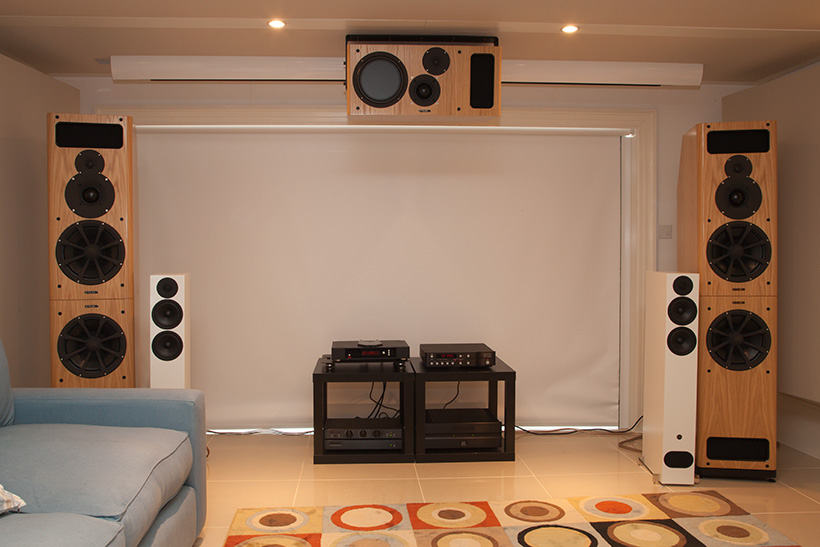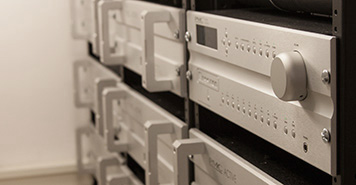Pete Thomas’ house by the sea, his pied a mer, recently featured in the Sunday Times Homes supplement, it was selected for the quality of its restoration, but that’s not what drew me to the seaside earlier in the summer. One aspect of the interior is somewhat at odds with grade II listing and that’s the dedicated music and cinema room that PMC’s co-founder and owner has built in the basement. This consists of a four and a half by eight metre space that has been extensively treated with the intent of creating a revealing and entertaining place to listen and watch.
The system installed in this room is a seven channel affair with PMC MB2-XBD-A SE active main stereo channels, the XBD element is a bass system that sits below each MB2. The surrounds are provided by PMC’s Wafer2 panels and the centre is a custom model based on a PMC IB2-A SE. Power is provided by Bryston amplification that is built to PMC’s specification, each MB2 has a 4B SST2 stereo amp for mid and treble and a 7B SST2 on the bass. There’s another 7B SST2 on each of the XBD bass cabinets which brings the total power for each channel up to an ‘adequate’ 1,800 Watts. Pete doesn’t like to do things by halves as you can tell, his experience with installations for recording studios has taught him that you need power to achieve control as well as level. A large well damped space like this room must soak up a lot of power but there is no sense that the reserves on tap are not up to the job. He put on a recording of bass and drums made straight from the desk without any compression or limiting and the power of the dynamics was astonishing, it revealed both the phenomenal capabilities of the system and the true extent of compromise in commercial releases.

The source for the main system is an Oppo BDP 105D Blu-ray player, which like the amplification is hidden in a cupboard at the back of the room. A cupboard under the stairs at that and one in which the temperature would be even higher if it didn’t have its own extraction system! Each pair of Wafers has a 4B SST2 behind it and the centre channel has active drive from the same amplification as found on the main left and right channels, so another 1,200 Watts, it’s a capable system that’s for sure.
In at attempt to give me a handle on the qualities of the room Pete and Keith ‘No sleep till Frinton’ Tonge had installed a more down to earth stereo system with the same speaker that I use at home, the PMC Fact.8. These were on the end of a Bryston BP26 preamplifier, 4B SST2 power amp and a Mark Levinson No.39 CD player, I took along a Rega Saturn-R and a Townshend Seismic Platform by way of contrast. This system revealed just how well sorted the room is, never have I heard extension like it, nor power for that matter. The absence of reflections at all frequencies means that you only hear what’s coming out of the speakers, the first impulse followed by the next with no reflections to smear them. It makes for resolution on a scale that one rarely encounters, every detail and nuance is easy to appreciate and as a result the quality of recordings becomes obvious. A state of affairs that has done nothing to undermine Pete’s enthusisasm for rare recordings and the many reissues of classic albums that have been released with outtakes as well as the original material.
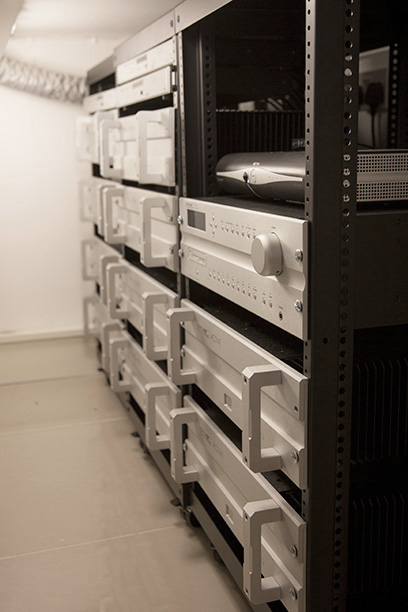 |
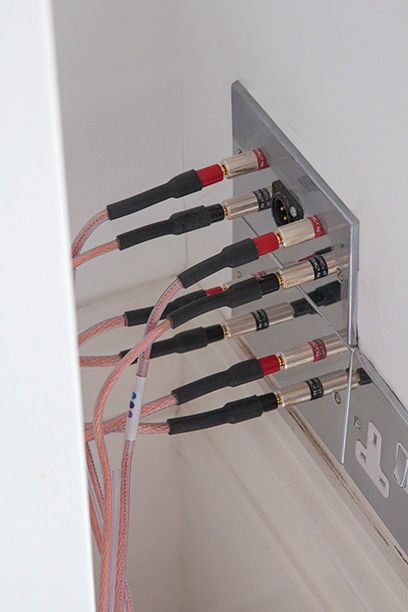 |
One example was Rumours 35th Anniversary, a three disc set that includes voice tracks such as Stevie Nicks’ ‘Dreams’ which sent shivers down my spine such was the sense of presence in the room. I put on a few discs of my own including Arab Strap’s Philophobia, the track ‘New Birds’ had been demmed to me by another speaker company and its gritty realism is very convincing. In this system the detail level is in another league, every breath is apparent and the depth of the image is completely at odds with the relatively shallow space behind the speakers. It put a lump in my throat I admit, and will make it sound less engrossing next time I play it at home, I’ll have to wait a while.
The room treatment was designed by Jochen Veith, a German acoustic engineer who specialises in recording studios. Pete considers him to be the very best in the business and listening in this room would suggest he knows his onions better than most. As well as wide bandwidth side panels there are bass traps in alcoves either side of a fireplace and further panels between the joists under a false ceiling. Happily the room does not feel dead in the way that control rooms often do, too much damping can make a system more analytical than enjoyable and while that’s good in a studio it’s a bit more than you need in a listening room. This room makes a distinct contrast with Ken Ishwata’s room that I heard recently, he went for a combination of damping and diffusion in order to maintain a more lively sound. The systems in the two rooms are completely different of course, Ken’s at the time would cost about the same as one of the main channels in Pete’s (if that) and I heard a lot more music in the Broadstairs room, and on speakers that I like a lot. But that aside if you want to hear everything on the recording and less of the listening room the carefully damped approach seems to be the most successful.

Playing a live recording such as Keith Jarrett’s Testament through the big system you can feel the body of the piano as well as the reverberant character of the Festival Hall where it was recorded. The system reveal’s Jarrett’s mutterings but at a much lower level than his playing, the dynamic range is massive, remarkably so for a commercial release. But then again ECM has always been better than most in this respect and Testament is one of its best Jarrett releases in terms of sound quality – the music ain’t bad either. This system delivers the attack of each note without the glare that most systems add as a result of clipping from the amplifier, limited dynamic capability in the speaker and the tendency for sound to bounce around the room. Bass is however the hardest thing to control, it goes through most damping panels and reflects back as if they weren’t there. The panels in Pete’s room have a membrane in them that can stop bass reflections, effectively acting as a non reflective barrier, not something you find in room treatment panels built for domestic listening rooms very often.
It’s the sort of room that makes assessing pieces of kit very straightforward so it was interesting to contrast the Rega and Mark Levinson CD players, the latter has a deliciously polished sound that’s calm and stately and sounds pretty impressive with many discs. But putting the Saturn-R on reveals that it’s a little sluggish in nature, not as strong on pace or for that matter pitch which seems to be a Rega speciality. I was surprised however that the more affordable player seemed equally revealing as well as being more engaging. The Seismic Platform benefitted both players in a similarly bass extending, image solidifying, detail resolving fashion. A result that inspired Pete to mention that PMC is now bundling Townshend’s Seismic Bases with some of the PMC speakers, he hadn’t got any in the listening room as yet however.
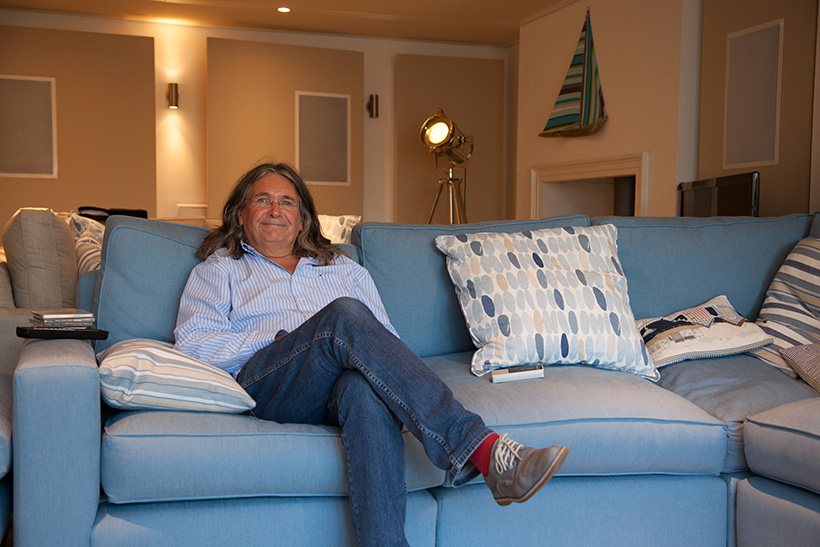
Pete Thomas has not only restored a listed building to a very high standard he has created one of the very best sounding rooms that I’ve heard, probably one of the best in the country for that matter. I could have stayed for longer and will undoubtedly be returning turntable in hand if I get the chance. Once you’ve heard a system of this calibre you have to hear it again, if for no other reason that to recalibrate your sense of what real bass sounds like.
Jason Kennedy
Q&A
JK: Doesn't the wide dispersion of your designs make the room interface more critical, ie a greater part of the result than with a more directional design?
PT: Horns and wave guides have narrow dispersion to negate the effects of the room but then they introduce a colouration that is not present on the original recording. They also don’t propagate the sound as the original recording or the individual instruments did. A very even off axis response replicates the recording far more naturally as your ear can hear that the direct sound and all the reflected sounds are one and the same (with a horn the little reflected stuff is very bandwidth limited and your ear certainly picks up on this). The wider dispersion also allows for a huge ‘hotspot’ rather than having to sit in one spot to get a decent image.
The room is designed as an analytical room that also has a natural balance across the whole bandwidth, so we can judge both tiny changes as well really delving into the recording and getting all that juicy musical feeling. This is extremely difficult especially in the bass region where most rooms have huge peaks and troughs). A really bright and highly reflective room wouldn’t be anywhere near as telling or involving as there would be stacks of reflections coming from all angles that would confuse the ear. It’s a bit like being in a modern restaurant (I’m sounding like an old man now!) rather than an old pub, where they haven’t treated the walls and everybody is talking and it ends up being difficult to focus on one sound.
More critical? Well with a horn you hear less of the room but more of what the horn sounds like, if you like the colouration/distortion of sound coming from a horn then that’s OK but if you prefer sound as it should be then its best to avoid the old horns.
